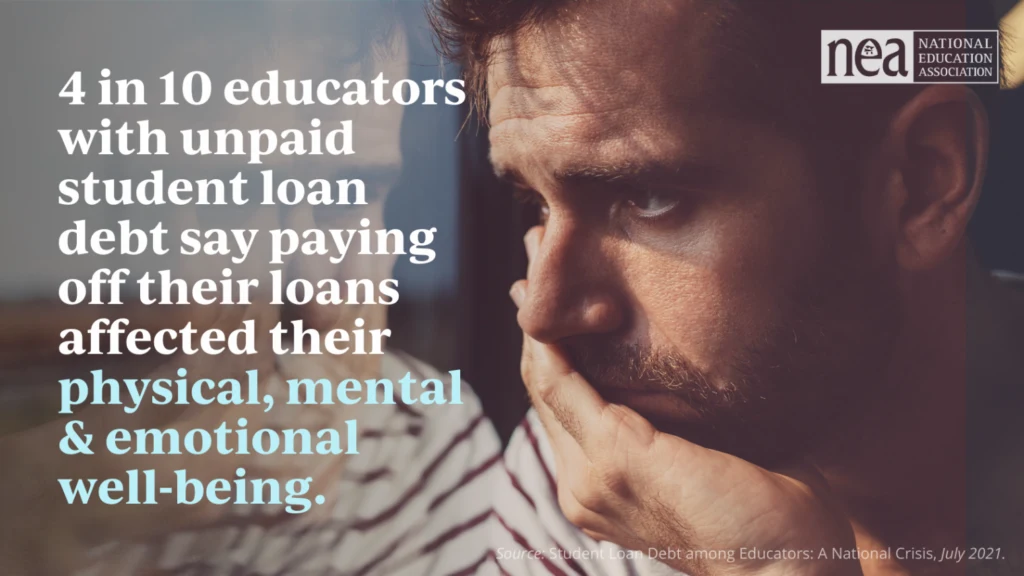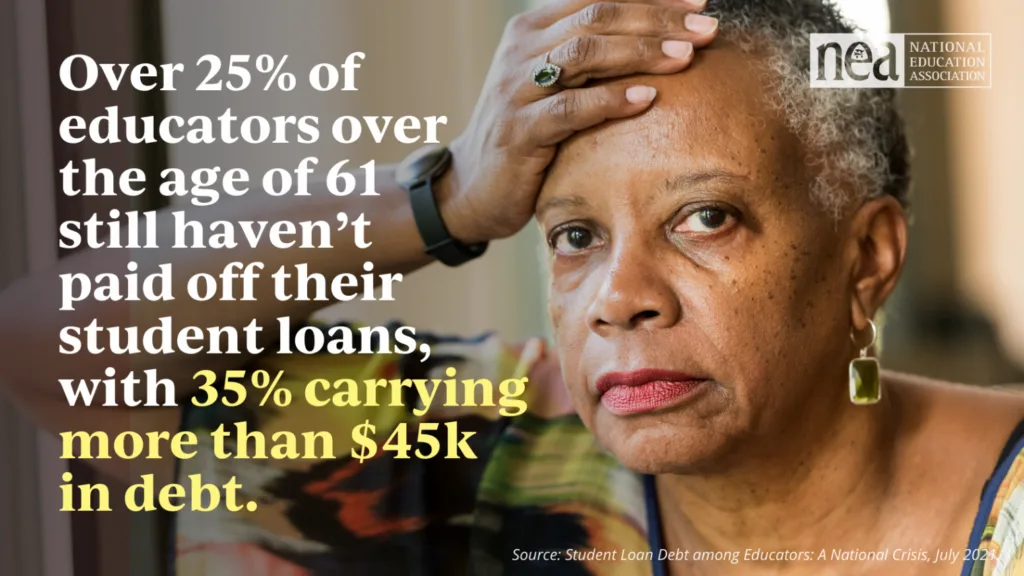The teaching profession, which used to be seen as honorable and given widespread respect, is facing an additional crisis that threatens its very foundation: student loan debt. The few aspiring educators we have in 2024, driven by a noble passion for shaping future generations, are increasingly burdened by the financial strain of repaying enormous student loans with a very low starting salary. This issue not only affects individual teachers but also has broader implications for the education system and society at large. Addressing student loan debt for teachers is crucial for maintaining a strong and effective education system. It is also another tool to help combat our enormous teaching shortage.

The Scope of the Problem
Recent data reveals that a significant number of teachers in the United States are grappling with substantial student loan debt. According to a survey by the National Education Association (NEA), approximately 45% of educators are repaying student loans, with an average debt amount exceeding $58,000. For many, this financial burden persists well into their careers, affecting their quality of life and professional satisfaction. As inflation increases and teacher salaries remain stagnant, this growing financial strain has led to a crisis in education that demands immediate attention.
Impact on Teachers

Financial Stress
The weight of student loan debt can lead to considerable financial stress. Teachers, particularly those in their early careers, often struggle to make ends meet. The average starting salary for teachers in many states hovers around $40,000, making it challenging to manage loan repayments while paying for living expenses. This financial stress can impact a new teacher’s ability to perform effectively in the classroom and pursue further professional development.
Career Choices
The pressure of student loan debt highly influences career decisions. Due to the additional financial burden, some teachers may be deterred from pursuing advanced degrees or certifications that could enhance their skills and career prospects. Others might leave the profession altogether in search of higher-paying jobs. Prospective teachers are often deterred from the career by others who focus on the low pay. This trend can exacerbate the already critical teacher shortage in many regions, particularly in underserved areas with Title I schools.

Mental Health
The stress associated with managing student loan debt can adversely affect teachers’ mental health. Anxiety, depression, and burnout are prevalent among educators, and these are exacerbated by financial worries. This is one of the many aspects of teaching that affects their well-being and their ability to provide quality education to students. Addressing the mental health impact of student loan debt is essential for ensuring a healthy and motivated teaching workforce.
Broader Implications for Education
Teacher Shortages
The financial challenges faced by teachers contribute to a growing shortage of qualified educators. Many school districts struggle to attract and retain teachers, especially in low-income and rural areas. This shortage can lead to larger class sizes, reduced individual attention for students, and a decline in educational quality. Addressing student loan debt and overall pay is crucial for solving the teacher shortage crisis.
Diversity in Education
Student loan debt disproportionately affects teachers of color, who are more likely to take out loans and owe larger amounts than white teachers. This disparity can hinder efforts to diversify the teaching workforce, which is crucial for providing inclusive and representative education. Ensuring diversity in education is vital for fostering an environment where all students feel seen and valued.

Quality of Education
Teachers burdened by debt may be less able to invest in their professional development and classroom resources. Since there is an unspoken understanding that teachers pay for much of their classroom materials, this is impossible for new teachers with low pay and high student loan repayments. This can negatively impact the quality of education they provide, affecting student outcomes and overall educational standards. A well-supported teaching workforce is essential for delivering high-quality education that meets the needs of all students.
Potential Solutions
There are many ways to address the issue of student loan debt for teachers.

Loan Forgiveness Programs
Expanding and improving loan forgiveness programs specifically for teachers can provide significant relief. Programs like Public Service Loan Forgiveness (PSLF) need to be more accessible and efficiently managed to ensure teachers benefit from them. Simplifying the application process and ensuring consistent program management can help more teachers achieve desperately needed loan forgiveness.
Competitive Salaries
Though salaries can vary greatly from state to state, increasing teacher salaries to more competitive levels would help alleviate financial stress and make the profession more attractive. States and districts need to prioritize budget allocations for teacher compensation. Higher salaries can also improve teacher retention rates and attract new talent to the profession.
Scholarships and Grants
Providing more scholarships and grants for education students can reduce the need for loans. Targeted financial aid can help aspiring teachers enter the profession with less debt. Expanding access to scholarships and grants can make teaching a more financially viable career choice. Surprisingly, some education majors are destined to make even less money than others.

Financial Education
Free financial literacy programs can help teachers manage their debt more effectively. Educators equipped with financial management skills can better navigate their loan repayments and overall financial health. Financial education can empower teachers to make informed decisions about their finances and reduce stress.
Conclusion
The student loan debt crisis among teachers is a serious issue that demands immediate attention. By implementing targeted solutions, we can alleviate the financial burden on educators, attract and retain talented professionals, and ensure a high-quality education system for future generations. Addressing student loan debt for teachers is crucial for maintaining a strong and effective education system. Investing in teachers is investing in the future, and it is imperative that we address this crisis with urgency and commitment.

